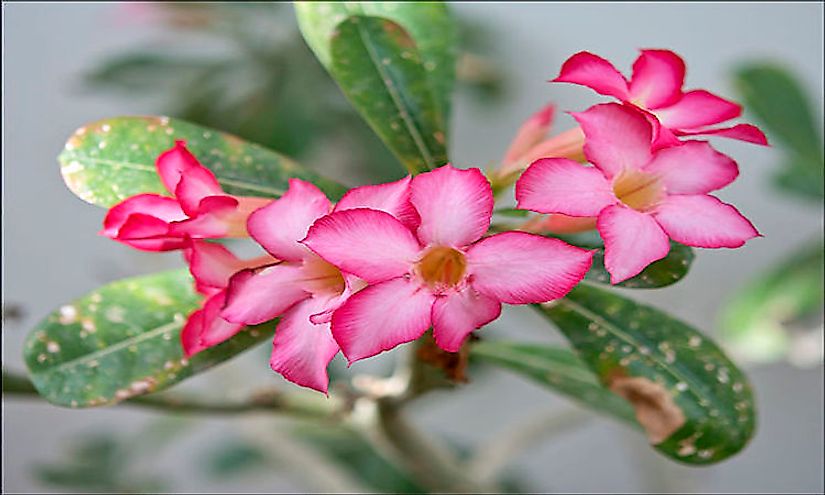Native Plant Species Of Chad

Chad's drought-resistant species of flora have long been employed in a wide range of traditional uses. From making medicines, to creating natural windbreakers and shelter beds, and provide timber and food to the locals. Among these native plant species is the desert rose, a beautiful shrub that has whitish, pink, and red flowers, and is drought resistant. Umbrella thorn Acacia has a long taproot and several lateral roots that help it absorb moisture in the almost dry soils. Hanza can either grow into a shrub or tree depending on the environment conditions of the growing environment. In this category is the Athel Tamarisk a dangerous and most stubborn invasive species to other countries but native to Chad where it grows along water courses.
Some Notable Native Plant Species Of Chad
Desert Rose
Desert Rose is a flowering plant species in the family Apocynaceae, native to the Sahel regions of Chad, Mauritania, Senegal, Sudan, and the tropical countries of southern Africa and Arabia. Desert Rose is usually a drought-deciduous succulent plant (or evergreen shrub that loses leaves during the cold seasons). Desert Rose grows to a height of 1-3 meters, has pachycaul stems and a swollen basal caudex. It has tubular fruits about 2-5 centimeters long that resemble flowers of Nerium and Plumeria. The flowers have a red and pink coloring and a whitish blush rising outwards. The leaves appear in a spiral arrangement, clustered towards the root shoots, and leathery in texture about 5-15 centimeters in length. Adenium obesum roots and stems produce a sap that has cardiac glycosides, used to poison large game hunting arrows and also as a fish toxin. Flowers start to appear in spring. Adenium obesum has a long lifespan of about 100 years and is almost resistant to dryness. It can also stand high temperatures of forty degree Celsius, but below thirty degrees the plant may start to die.
Umbrella Thorn Acacia
Umbrella thorn acacia is a medium-sized evergreen shrub or tree that grows to a height of 1 meter if it is a shrub and 21 meters as a tree. It develops into a big umbrella-like and spreading canopy.Umbrella thorn Acacia is drought resistant. It can stand high saline environments and seasonally waterlogged soils. It grows in open and dry forests and can stand in straight lines or mix with other plant species. It has a long taproot and many lateral roots which enable it to use the limited soil moisture found in the arid areas. Also, it can stand temperatures as high as fifty degrees Celsius and as low as zero. The tree is native to Chad, Angola, Kenya, Ethiopia, Tanzania, Namibia, Mozambique, Somali, South Africa, Sudan, Egypt, Iran, Israel, United Arab Emirates, Zimbabwe, and Zambia. It is a multi-purpose tree providing timber, food, medicines, fuels, tannins, and also used in irrigation schemes a soil stabilizer and shelterbelts. It prefers habitats that are either Savannah or woodlands.
Hanza
Hanza is an evergreen tree or shrub varying in size according to habitat. In areas that experience extreme aridity the species grows into a shrub of 2 meters in height, but in moist environments, it grows into a rounded tree with a spreading crown. Hanza is native to Chad, Senegal, Mauritania, Somali, Egypt, and Kenya. It prefers arid environments like stony slopes, cracking clay plains, and sand dunes. It also grows in desiccated, hard, barren and fire-scorched regions. In other cases, it sprouts directly from termite mounds.
Athel Tamarisk
Athel Tamarisk is a fast-growing evergreen tree native to Chad and other countries in Central, North, and East Africa, Middle East, and Southern and Western Asia. The plant grows along watercourses in the arid areas of these countries. It is resistant to alkaline and saline environments. Athel Tamarisk grows to a height of about 18 meters. It has tiny leaves arranged alternately along the branches. These branches excrete salt which then forms crusts on the leaf surface and then drip onto the ground. The leaves are bluish-green, and flowers are whitish pink and small about 3-6 mm.Tamarix aphylla reproduces by suckering or seed. The species usually sheds its leaves and branchlets in the cold season and in May new shoots and leaves appear. Athel Tamarisk is monoecious. From May to July, small pinkish flowers appear and in the cold season, capsules ripen. Ripe capsules are brown in color, and when they open, they release seeds. In Africa, people use it as a natural windbreaker and also as a shade. Wind and water quickly dispense these seeds. A single tree produces thousands of seeds in a single year.
Adaptation Of The Plants To The Arid Environments
These drought-resistant native species are in stable population surviving the dry and cold climate of the environments they grow in. The plants have structures like long tap roots or long and succulent leaves, to help them survive the harsh conditions.
Native Plant Species Of Chad
| Native Plants of Chad | Scientific Name |
|---|---|
| Desert Rose | Adenium obesum |
| Umbrella Thorn Acacia | Vachellia tortilis |
| Hanza | Boscia senegalensis |
| Athel Tamarisk | Tamarix aphylla |
| Karira | Capparis decidua |
| Thorn Apple | Solanum incanum |
| Salt Reed Grass | Desmostachya bipinnata |
| Merkba Bunch-Grass | Panicum turgidum |
| African Mahogany | Khaya senegalensis |
| Chari River Medlar | Vangueria chariensis |











